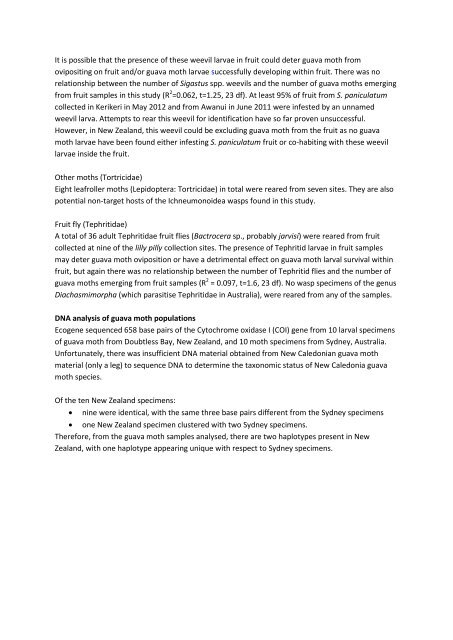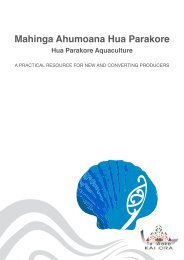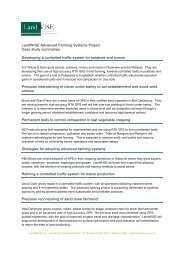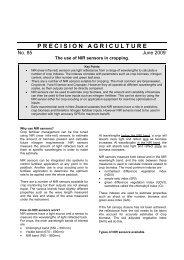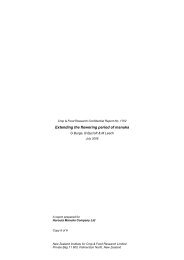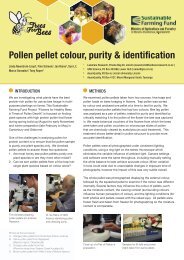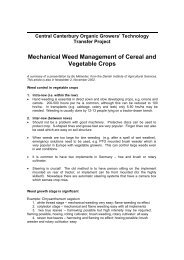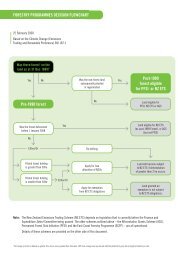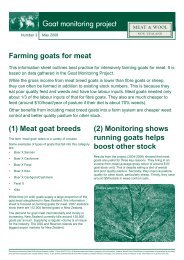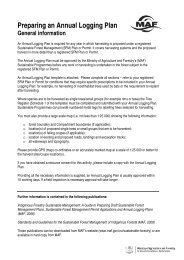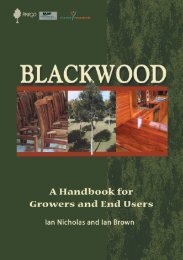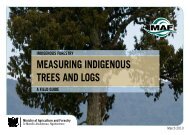Biological control agents for the guava moth, Coscinoptycha ...
Biological control agents for the guava moth, Coscinoptycha ...
Biological control agents for the guava moth, Coscinoptycha ...
Create successful ePaper yourself
Turn your PDF publications into a flip-book with our unique Google optimized e-Paper software.
It is possible that <strong>the</strong> presence of <strong>the</strong>se weevil larvae in fruit could deter <strong>guava</strong> <strong>moth</strong> fromovipositing on fruit and/or <strong>guava</strong> <strong>moth</strong> larvae successfully developing within fruit. There was norelationship between <strong>the</strong> number of Sigastus spp. weevils and <strong>the</strong> number of <strong>guava</strong> <strong>moth</strong>s emergingfrom fruit samples in this study (R 2 =0.062, t=1.25, 23 df). At least 95% of fruit from S. paniculatumcollected in Kerikeri in May 2012 and from Awanui in June 2011 were infested by an unnamedweevil larva. Attempts to rear this weevil <strong>for</strong> identification have so far proven unsuccessful.However, in New Zealand, this weevil could be excluding <strong>guava</strong> <strong>moth</strong> from <strong>the</strong> fruit as no <strong>guava</strong><strong>moth</strong> larvae have been found ei<strong>the</strong>r infesting S. paniculatum fruit or co-habiting with <strong>the</strong>se weevillarvae inside <strong>the</strong> fruit.O<strong>the</strong>r <strong>moth</strong>s (Tortricidae)Eight leafroller <strong>moth</strong>s (Lepidoptera: Tortricidae) in total were reared from seven sites. They are alsopotential non-target hosts of <strong>the</strong> Ichneumonoidea wasps found in this study.Fruit fly (Tephritidae)A total of 36 adult Tephritidae fruit flies (Bactrocera sp., probably jarvisi) were reared from fruitcollected at nine of <strong>the</strong> lilly pilly collection sites. The presence of Tephritid larvae in fruit samplesmay deter <strong>guava</strong> <strong>moth</strong> oviposition or have a detrimental effect on <strong>guava</strong> <strong>moth</strong> larval survival withinfruit, but again <strong>the</strong>re was no relationship between <strong>the</strong> number of Tephritid flies and <strong>the</strong> number of<strong>guava</strong> <strong>moth</strong>s emerging from fruit samples (R 2 = 0.097, t=1.6, 23 df). No wasp specimens of <strong>the</strong> genusDiachasmimorpha (which parasitise Tephritidae in Australia), were reared from any of <strong>the</strong> samples.DNA analysis of <strong>guava</strong> <strong>moth</strong> populationsEcogene sequenced 658 base pairs of <strong>the</strong> Cytochrome oxidase I (COI) gene from 10 larval specimensof <strong>guava</strong> <strong>moth</strong> from Doubtless Bay, New Zealand, and 10 <strong>moth</strong> specimens from Sydney, Australia.Un<strong>for</strong>tunately, <strong>the</strong>re was insufficient DNA material obtained from New Caledonian <strong>guava</strong> <strong>moth</strong>material (only a leg) to sequence DNA to determine <strong>the</strong> taxonomic status of New Caledonia <strong>guava</strong><strong>moth</strong> species.Of <strong>the</strong> ten New Zealand specimens:• nine were identical, with <strong>the</strong> same three base pairs different from <strong>the</strong> Sydney specimens• one New Zealand specimen clustered with two Sydney specimens.There<strong>for</strong>e, from <strong>the</strong> <strong>guava</strong> <strong>moth</strong> samples analysed, <strong>the</strong>re are two haplotypes present in NewZealand, with one haplotype appearing unique with respect to Sydney specimens.


